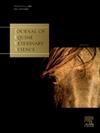Optimizing sperm selection: Effects of microfluidic and colloidal centrifugation processing on DNA fragmentation in thawed stallion sperm
IF 1.6
3区 农林科学
Q2 VETERINARY SCIENCES
引用次数: 0
Abstract
Ensuring the integrity of sperm DNA is vital for the success of assisted reproductive technologies (ART) because DNA fragmentation can compromise fertilization outcomes and embryo development. Cryopreservation is a widely used technique for sperm storage; however, the freezing, thawing, and subsequent sperm selection processes can exacerbate DNA damage, presenting significant challenges for its application in ART. Identifying effective sperm selection methods to minimize post-thaw DNA fragmentation is crucial for improving ART success rates. This study evaluated post-thaw sperm DNA fragmentation in cryopreserved sperm from 6 stallions (n = 6) with 2 replicates per stallion. Cryopreserved straws were thawed for 30 s in a water bath set at 37°C and diluted 1:2.5 with Botusemen® Gold (Botupharma USA, Phoenix, AZ, USA) before being processed using either a microfluidic device (VetMotl; VetMotl Inc., Gaithersburg, MD, USA), colloidal centrifugation at 400 × g for 20 min (EquiPure; NidaCon International AB, Sweden), or left unprocessed (control). After undergoing their respective selection methods, all samples were flash-frozen and stored at −80°C until further analysis. Sperm DNA fragmentation was assessed based on the percentage of cells outside the main population (COMPαt) as determined by the Sperm Chromatin Structure Assay (SCSA). Two samples from a fertile control stallion were used to calibrate the flow cytometer for consistent analysis. Analysis was performed by individuals blinded to treatment. Statistical analysis was performed using R (R Core Team, Vienna, Austria, v3.6.0) to fit a mixed linear regression model. The model included treatment method (control, EquiPure, VetMotl) as a fixed effect and stallion as a random effect. No significant differences were observed between stallions (P = 0.074). VetMotl processing resulted in significantly lower (P < 0.001) DNA damage (5.59% ± 1.17) compared with both control (12.95% ± 1.84) and EquiPure (14.61% ± 2.21) treatments. These findings suggest that microfluidic sperm processing may be a promising approach for reducing DNA damage in thawed cryopreserved stallion sperm intended for assisted reproduction.
优化精子选择:微流体和胶体离心处理对解冻种马精子DNA片段化的影响
确保精子DNA的完整性对于辅助生殖技术(ART)的成功至关重要,因为DNA片段化会影响受精结果和胚胎发育。冷冻保存是一种广泛使用的精子储存技术;然而,冷冻、解冻和随后的精子选择过程会加剧DNA损伤,这对其在ART中的应用提出了重大挑战。确定有效的精子选择方法以最大限度地减少解冻后DNA断裂对于提高ART成功率至关重要。本研究对6匹公马(n = 6)冷冻保存的精子进行解冻后DNA片段的分析,每匹公马进行2次重复。冷冻保存的吸管在37°C的水浴中解冻30 s,用Botusemen®Gold (Botupharma USA, Phoenix, AZ, USA)稀释1:25 .5,然后使用微流控装置(VetMotl;VetMotl Inc., Gaithersburg, MD, USA),胶体离心400 × g 20分钟(EquiPure;NidaCon International AB,瑞典),或未经处理(对照)。经过各自的选择方法后,所有样品被快速冷冻并保存在- 80°C,等待进一步分析。根据精子染色质结构测定法(SCSA)测定的主群体外细胞百分比(COMPαt)来评估精子DNA片段。两份来自可育对照种马的样品被用来校准流式细胞仪以进行一致的分析。分析是由对治疗不知情的个体进行的。采用R (R Core Team, Vienna, Austria, v3.6.0)进行统计分析,拟合混合线性回归模型。模型以治疗方法(对照、EquiPure、VetMotl)为固定效应,种马为随机效应。不同种马间无显著差异(P = 0.074)。VetMotl处理导致(P <;0.001) DNA损伤(5.59%±1.17),而对照组(12.95%±1.84)和EquiPure组(14.61%±2.21)。这些发现表明,微流体精子处理可能是一种很有前途的方法,可以减少用于辅助生殖的解冻冷冻种马精子的DNA损伤。
本文章由计算机程序翻译,如有差异,请以英文原文为准。
求助全文
约1分钟内获得全文
求助全文
来源期刊

Journal of Equine Veterinary Science
农林科学-兽医学
CiteScore
2.70
自引率
7.70%
发文量
249
审稿时长
77 days
期刊介绍:
Journal of Equine Veterinary Science (JEVS) is an international publication designed for the practicing equine veterinarian, equine researcher, and other equine health care specialist. Published monthly, each issue of JEVS includes original research, reviews, case reports, short communications, and clinical techniques from leaders in the equine veterinary field, covering such topics as laminitis, reproduction, infectious disease, parasitology, behavior, podology, internal medicine, surgery and nutrition.
 求助内容:
求助内容: 应助结果提醒方式:
应助结果提醒方式:


